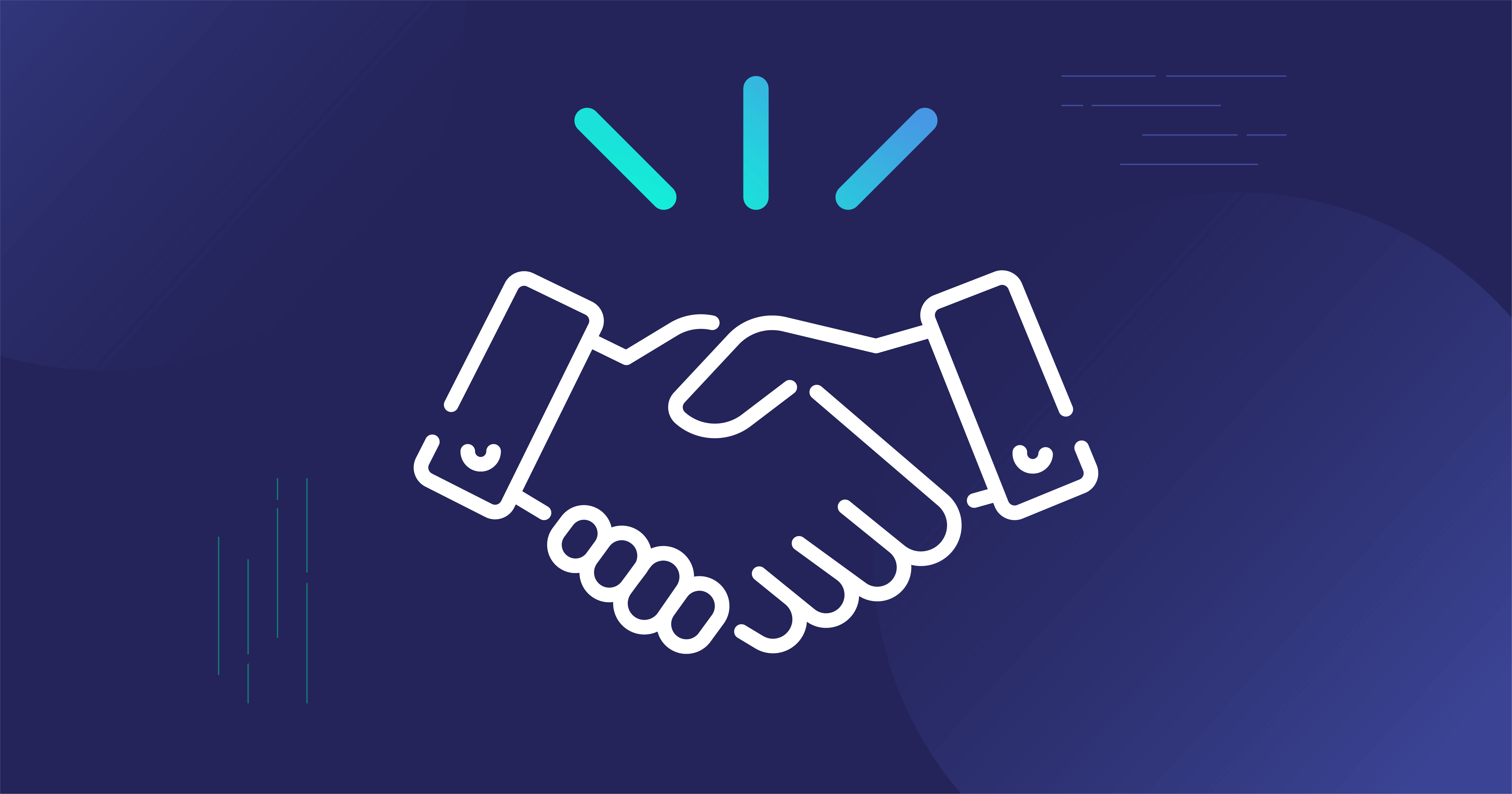Most SaaS companies don't start as powerhouses with hundreds of employees. Instead, they usually begin with a handful of people – often just enough to handle critical company functions. Then you grow with your sales, ensuring that your costs don't substantially outpace revenue.
That's where channel partnerships can help. Channel partnerships can provide a path to scale your sales growth without scaling costs accordingly.
We introduced channel partnerships in our overview post on SaaS partner programs, but now we'd like to get into the details.
What are channel partnerships?
Channel partnerships are relationships between you and other companies (channel partners) that allow you to offload some portion of your marketing, sales, onboarding, or support tasks to those partners.
You allow others to offer your product in the market, and your partners gain revenue by selling your product and related services. You don't have to grow your teams to do this. Instead, your partners act as a secondary sales team and do some of the work of selling and servicing your product.
Understanding the importance of SaaS channel partnerships
While a few SaaS companies have grown huge without channel partner programs, they are in the minority. Companies from Atlassian to Shopify, and many others, have built out extensive channel partner ecosystems. These ecosystems have massively accelerated revenue growth beyond what the companies could have managed independently.
For example, Shopify has several partner programs, but its Shopify Affiliate Program is an excellent example of a channel partnership. Through that program, Shopify has tens of thousands of affiliates worldwide. In 2020, Shopify Partners (channel and otherwise) created $12.5 billion in revenue. For its part, Atlassian estimates that one-third of all its revenue involves its partners.
What are the types of channel partnerships?
While there are many different perspectives on (and names) for types of channel partnerships, we've found the following terms helpful for understanding SaaS channel partnerships:
- Indirect Sales Partner: Someone who brokers sales for you in a specific market. They incur the costs of acquiring customers, so you don't have to. This type of partnership might exist when Company A needs to sell in a new country but doesn't have a presence there. It then partners with Company B (with an existing sales network in that country) for indirect sales.
- Referral Partner: Someone who directly refers potential customers to you. A referral partner can sometimes be known as an affiliate partner. Referral/affiliate partners can be companies or individuals.
- Reseller Partner: Someone who markets and sells your product, but usually to specific market sectors and with add-ons (additional products and services). In some cases, the reseller may even white label your product.
All of these may receive commissions based on sales and participate in other revenue-sharing arrangements.
The benefits and challenges of SaaS channel partner programs
We've touched on the benefits of channel partner programs for your partners (commissions and revenue sharing), but what are the benefits for your company? What value do you get from building channel partner relationships?
Here are a few of the benefits:
- Short path to new customers. In most cases, your channel partners already have customers. Getting them to refer those customers to you (or sell them your product) is a great way to get past the "I don't know you" phase.
- Increase bottom line. You are ahead of the curve if you don't need to hire additional people, but your sales increase substantially. You'll be sharing the revenue with your channel partners, which means you have revenue to share.
- New market exposure. Channel partners often have connections in specific market sectors that you don't. Via your partnership, you can ride their coattails into relationships that you would otherwise have taken years to build.
- Tap into new resources. Your channel partners have the people and the skills to help you do more with less. You are bringing your product to the relationship, and they may be bringing prospects, sales and marketing skills, and even training and support capabilities.
As with anything else worthwhile, channel partnerships require work. No matter what exact shape your channel partnership program takes, you'll probably need to address the following challenges:
- Greater distance from critical data. Whether we are talking about the sales data for forecasting and planning or what's going on with each customer's account (customer needs, customer sentiment, market trends, and product feedback), you will not have the same access to the channel accounts as you currently do with your direct accounts. You'll need to factor in this added distance to ensure that you minimize the possibility of miscommunication and poor planning.
- Shared brand responsibility. Managing your brand was more straightforward when it was just you. However, once you have channel partners, you've authorized them to act for your brand. Staying on top of branding and marketing and having clear rules and consequences is critical.
- Channel conflicts. You've set up the channel partnership to broaden your market, but it is nearly inevitable that you will run into channel conflicts. This happens when your internal sales team is trying to sell to the same customers as your channel partners. The best way to get out in front of conflicts is to have clear rules and roles and a straightforward process for resolving conflicts when they arise.
How to build a SaaS channel partner program
Here are a few high-level items to remember as you figure out how to work with channel partnerships.
Make sure your team is ready
Before you add a channel partner program, you must ensure your organization is ready. Have you reached product-market fit and successfully executed your growth plan?
Adding a channel partner program requires resources. Do you have those resources in place, or have they been allocated within the budget? Are you realistic with how much time and effort a new channel partner program will require?
While you may not need to add new people to your sales and marketing teams, you also shouldn't expect that an existing resource in one of those teams will be able to manage your channel partner relationships at scale. It's not uncommon for channel partnerships to require a team to manage them properly. And that's probably a full-time job for these team members.
Determine the type of partner program you need
We've touched on several types of channel partner programs. However, the underlying business need you are solving should help you determine the right partner program for your situation.
Do you need to break into a new market where you just aren't getting traction? Then, a reseller partnership may be the way to go. Do you need to increase sales without substantially increasing your sales team? A referral partnership might be right for you. Do you need to broaden your appeal within a new geographic region? An indirect sales partnership could be just what you need.
And, of course, what is your overall channel partner strategy? Will you only have a single program, or will you create several? Will the programs be similar or differ widely from each other?
Define your ideal partner
You should already have criteria to define your Ideal Customer Profile (ICP) for sales. In the same way, you should define an Ideal Partner Profile (IPP) for your partnership program.
Criteria should include size, market vertical, market penetration, and geographic region. Other criteria might include business culture, startup/business stage, or growth opportunity. The list of criteria should be detailed enough to help you narrow your focus to those partners who will best support the program you are establishing.
Define the incentives and goals for the program
Incentives may be both internal and external. Internal incentives include commissions for signing up partners or meeting partner sales goals. External incentives for your partners may consist of one-time payments, revenue-sharing agreements, and co-marketing events.
You'll also want to define specific goals for the program. It may be revenue ("Increase sales of X by 15%, using indirect sales partners"), visibility ("ensure that we are quoting 20% of the new business this year in X vertical"), or something else entirely. And the goals must be tangible and quantifiable. In addition to internal goals for the program, you may wish to have specific goals for each partner.
Your current sales and marketing processes are all tied to your internal teams. Adding in channel partners means you'll need to revamp many of those processes and add several new ones. Among other things, you'll need to add procedures for onboarding and training partners, joint marketing planning, and handling legal matters such as contracting and liability.
Invite and onboard your partners
Once you've determined the pool of possible channel partners, you should invite them to the program. By now, you should have a solid idea of what you are trying to achieve with the program. You'll want to create a channel partner agreement (contract) that establishes roles and responsibilities for both parties, incentives, and timeframes.
After the contracts are in place, it's time for your partner team to onboard the new folks. This will vary, of course, based on the program particulars. However, it will often include setting up channel partners to access a partner dashboard or PRM (partnership management) software and providing them with specific product and program-specific documentation, which may include anything from marketing materials to technical guides.
Review and revise as you go
You'll likely see things that should change before you even get your channel partner program going. Are individual goals for partners more of a stretch than anticipated? Dial them back before your partners get frustrated. Did you get fewer partners than will be required to meet your overall goals? Review your partner criteria and see if you can add more channel partners to the program.
Once a particular channel partner program is up and running successfully, you can leverage what you've learned to put together other channel partner programs (for different geographic regions, market verticals, or organization sizes). The market keeps changing, and you'll need to keep refining your channel partner ecosystem to keep pace.
Are channel partnerships in your future?
Channel partnerships can make the difference between seeing modest growth and watching your sales take off. Once you have a product and a defined place in the market, channel partnerships can accelerate your sales growth without requiring huge investments.
Proper planning up front can help you maximize the benefits and mitigate the challenges of channel partner programs. There is no "one-size-fits-all" approach to channel partnerships, so you can tailor one to exactly what you need for your product, partners, and customers.




